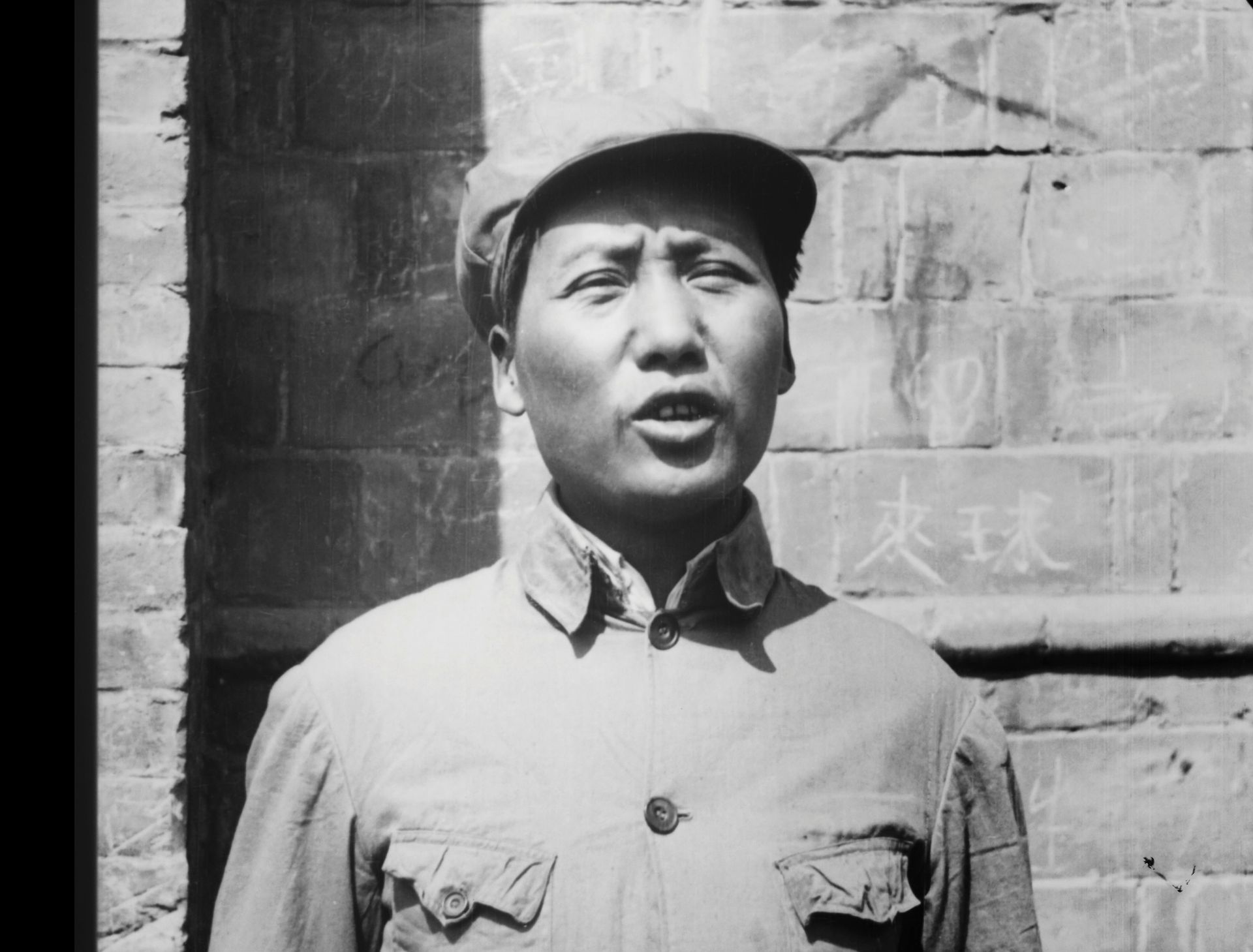Description
「延安內貌」 1938年攝於延安的第一部新聞片(片長14分鐘),原版35毫米電影正片拷貝,為最 早在銀幕上出現毛澤東鏡頭的新聞紀錄片。 又名「西北線上」,由林蒼、徐天翔製片、導演,金昆攝影,中國戰時電影研究會監 制,於1938年3月左右赴延安拍攝,但直到1941年才更名為「延安內貌」得以公映。 展現長征的照片相當罕見,展現其終點延安的照片更是如此。而電影鏡頭更是鳳 毛麟角。尤其難得的是在這部出色的影片中,有史以來第一次在銀幕上看到毛澤東和 其他中共領導人生動的形象,包括劉少奇、丁玲、羅瑞卿、康生等等。 本件「延安內貌」為35毫米硝酸鹽(賽璐珞)膠片原始電影拷貝,片長14分鐘。影 片在拍攝過程中並沒有現場錄音,本拷貝的聲帶由當時的三首革命歌曲組成:「三大紀 律八項注意」;「邊區十唱」(後改編並更名為「軍民大生產」收入大型音樂史詩「東方 紅」之中);第三首不詳。 1974年,該影片的香港製作人之一將此硝酸鹽拷貝出讓,並說明原始底片與所有工 作拷貝都已遺失,這份正片拷貝應是獨一無二了。 硝酸鹽(賽璐珞)膠片對安全妥善的保存有一定要求。因此,後期製作了一份35 毫米安全負片拷貝和4K數字修復版。我們還製作了一份數字樣本,畫面中以對角線分 割,將數字版與原始膠片畫面呈現在一起,以便觀察驚人的修復效果(請見鏈接)。 香港電影資料館的目錄中,顯示館藏有一份不含聲軌的「延安內貌」VHS錄像帶。 在中國大陸,也很難找到這部非常罕見的電影,互聯網上僅有影片信息,但沒有任何視 頻鏈接。如此重要的影片,未在任何中國與黨史相關的歷史場所展映,甚至未有簡單的 存檔。因此,它需要獲得更多的關注,讓大家有更多的渠道得以觀摩。 收藏於普林斯頓大學的一本小冊子包含了對這部電影的推介。該刊物的主題是電 影「滿江紅」(1949),但首兩頁推介了「延安內貌」,稱其為『珍貴革命文獻,全部真實紀 錄』。 Scenes of Life in YanAn The original positive 35mm print of the first newsreel (14 mins.) shot in YanAn in 1938, in which Mao ZeDong is filmed for the first time. Lin Cang 林蒼 & Xu TianXiang 徐天翔 (production, direction), Jin Kun 金崑 (camera). Filmed around March 1938 under the auspices of the China Wartime Film Research Association, but not publicly screened until 1941. Photographs of the Long March are very rare, as are those of its endpoint in YanAn, the communist base of Northwest China in ShaanXi 陝西 province. Moving pictures are even rarer. And rarer still is this exceptional film, in which for the first time ever, in motion on the screen, Mao ZeDong may be seen along with other Chinese Communist leaders, including Liu ShaoQi, Ding Ling, Luo RuiJing, and Kang Sheng. 「延安內貌」「 YanAn NeiMao」「 Scenes of Life in YanAn」 is a nitrate-base 35-mm film, 14 minutes in length with no direct sound recording. When it was edited, three revolutionary songs of the time were added (the third being unidentified):「三大紀律八項注意」; and 「軍民大生產」which became 「邊區十唱」and would be integrated into 「東方紅」. In 1974, a member of the production crew, a filmmaker from HongKong, parted with this nitrate and explained that the negative and all working prints had been lost, and that this nitrate was therefore probably unique. Nitrates require special conservation methods. So a 35 mm safety internegative was produced as well as a 4K digital version. Cf the digital version, in a diagonal half-frame format along with the original, which makes possible to view both the raw nitrate and its stabilized and recalibrated digitized restoration. The title appears in the catalogue of the HongKong cinémathèque, but all there is in their collections is a VHS cassette with no sound track. In China it was impossible to track this very rare film down, and there was no sign of it on the internet. Nor can the film be found, either screenable or simple archived, at any of the dedicated memorial sites of the History of Chinese communism. It has thus yet to be made known and available for any historical or even official purposes. A brochure held by Princeton University contains the first printed allusion to the film. The publication's main subject is「儺 ManJiangHong「滿江紅」, but two of its pages describe the particularly rare newsree「l 延安內貌」 YanAn NeiMao. Online catalogue: https://fr.zone-secure.net/29754/1369142/#page=1
1
Online
「延安內貌」 1938年攝於延安的第一部新聞片(片長14分鐘),原版35毫米電影正片拷貝,為最 早在銀幕上出現毛澤東鏡頭的新聞紀錄片。 又名「西北線上」,由林蒼、徐天翔製片、導演,金昆攝影,中國戰時電影研究會監 制,於1938年3月左右赴延安拍攝,但直到1941年才更名為「延安內貌」得以公映。 展現長征的照片相當罕見,展現其終點延安的照片更是如此。而電影鏡頭更是鳳 毛麟角。尤其難得的是在這部出色的影片中,有史以來第一次在銀幕上看到毛澤東和 其他中共領導人生動的形象,包括劉少奇、丁玲、羅瑞卿、康生等等。 本件「延安內貌」為35毫米硝酸鹽(賽璐珞)膠片原始電影拷貝,片長14分鐘。影 片在拍攝過程中並沒有現場錄音,本拷貝的聲帶由當時的三首革命歌曲組成:「三大紀 律八項注意」;「邊區十唱」(後改編並更名為「軍民大生產」收入大型音樂史詩「東方 紅」之中);第三首不詳。 1974年,該影片的香港製作人之一將此硝酸鹽拷貝出讓,並說明原始底片與所有工 作拷貝都已遺失,這份正片拷貝應是獨一無二了。 硝酸鹽(賽璐珞)膠片對安全妥善的保存有一定要求。因此,後期製作了一份35 毫米安全負片拷貝和4K數字修復版。我們還製作了一份數字樣本,畫面中以對角線分 割,將數字版與原始膠片畫面呈現在一起,以便觀察驚人的修復效果(請見鏈接)。 香港電影資料館的目錄中,顯示館藏有一份不含聲軌的「延安內貌」VHS錄像帶。 在中國大陸,也很難找到這部非常罕見的電影,互聯網上僅有影片信息,但沒有任何視 頻鏈接。如此重要的影片,未在任何中國與黨史相關的歷史場所展映,甚至未有簡單的 存檔。因此,它需要獲得更多的關注,讓大家有更多的渠道得以觀摩。 收藏於普林斯頓大學的一本小冊子包含了對這部電影的推介。該刊物的主題是電 影「滿江紅」(1949),但首兩頁推介了「延安內貌」,稱其為『珍貴革命文獻,全部真實紀 錄』。 Scenes of Life in YanAn The original positive 35mm print of the first newsreel (14 mins.) shot in YanAn in 1938, in which Mao ZeDong is filmed for the first time. Lin Cang 林蒼 & Xu TianXiang 徐天翔 (production, direction), Jin Kun 金崑 (camera). Filmed around March 1938 under the auspices of the China Wartime Film Research Association, but not publicly screened until 1941. Photographs of the Long March are very rare, as are those of its endpoint in YanAn, the communist base of Northwest China in ShaanXi 陝西 province. Moving pictures are even rarer. And rarer still is this exceptional film, in which for the first time ever, in motion on the screen, Mao ZeDong may be seen along with other Chinese Communist leaders, including Liu ShaoQi, Ding Ling, Luo RuiJing, and Kang Sheng. 「延安內貌」「 YanAn NeiMao」「 Scenes of Life in YanAn」 is a nitrate-base 35-mm film, 14 minutes in length with no direct sound recording. When it was edited, three revolutionary songs of the time were added (the third being unidentified):「三大紀律八項注意」; and 「軍民大生產」which became 「邊區十唱」and would be integrated into 「東方紅」. In 1974, a member of the production crew, a filmmaker from HongKong, parted with this nitrate and explained that the negative and all working prints had been lost, and that this nitrate was therefore probably unique. Nitrates require special conservation methods. So a 35 mm safety internegative was produced as well as a 4K digital version. Cf the digital version, in a diagonal half-frame format along with the original, which makes possible to view both the raw nitrate and its stabilized and recalibrated digitized restoration. The title appears in the catalogue of the HongKong cinémathèque, but all there is in their collections is a VHS cassette with no sound track. In China it was impossible to track this very rare film down, and there was no sign of it on the internet. Nor can the film be found, either screenable or simple archived, at any of the dedicated memorial sites of the History of Chinese communism. It has thus yet to be made known and available for any historical or even official purposes. A brochure held by Princeton University contains the first printed allusion to the film. The publication's main subject is「儺 ManJiangHong「滿江紅」, but two of its pages describe the particularly rare newsree「l 延安內貌」 YanAn NeiMao. Online catalogue: https://fr.zone-secure.net/29754/1369142/#page=1
You may also like
